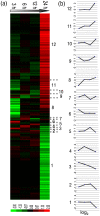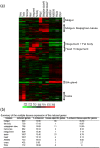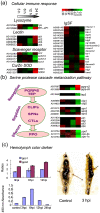A genome-wide survey for host response of silkworm, Bombyx mori during pathogen Bacillus bombyseptieus infection
- PMID: 19956592
- PMCID: PMC2780328
- DOI: 10.1371/journal.pone.0008098
A genome-wide survey for host response of silkworm, Bombyx mori during pathogen Bacillus bombyseptieus infection
Abstract
Host-pathogen interactions are complex relationships, and a central challenge is to reveal the interactions between pathogens and their hosts. Bacillus bombysepticus (Bb) which can produces spores and parasporal crystals was firstly separated from the corpses of the infected silkworms (Bombyx mori). Bb naturally infects the silkworm can cause an acute fuliginosa septicaemia and kill the silkworm larvae generally within one day in the hot and humid season. Bb pathogen of the silkworm can be used for investigating the host responses after the infection. Gene expression profiling during four time-points of silkworm whole larvae after Bb infection was performed to gain insight into the mechanism of Bb-associated host whole body effect. Genome-wide survey of the host genes demonstrated many genes and pathways modulated after the infection. GO analysis of the induced genes indicated that their functions could be divided into 14 categories. KEGG pathway analysis identified that six types of basal metabolic pathway were regulated, including genetic information processing and transcription, carbohydrate metabolism, amino acid and nitrogen metabolism, nucleotide metabolism, metabolism of cofactors and vitamins, and xenobiotic biodegradation and metabolism. Similar to Bacillus thuringiensis (Bt), Bb can also induce a silkworm poisoning-related response. In this process, genes encoding midgut peritrophic membrane proteins, aminopeptidase N receptors and sodium/calcium exchange protein showed modulation. For the first time, we found that Bb induced a lot of genes involved in juvenile hormone synthesis and metabolism pathway upregulated. Bb also triggered the host immune responses, including cellular immune response and serine protease cascade melanization response. Real time PCR analysis showed that Bb can induce the silkworm systemic immune response, mainly by the Toll pathway. Anti-microorganism peptides (AMPs), including of Attacin, Lebocin, Enbocin, Gloverin and Moricin families, were upregulated at 24 hours post the infection.
Conflict of interest statement
Figures









Similar articles
-
Genome-Wide Analysis of Host Responses to Four Different Types of Microorganisms in Bombyx Mori (Lepidoptera: Bombycidae).J Insect Sci. 2016 Jul 5;16(1):69. doi: 10.1093/jisesa/iew020. Print 2016. J Insect Sci. 2016. PMID: 27382132 Free PMC article.
-
Transcriptome analysis of differentially expressed genes involved in innate immunity following Bacillus thuringiensis challenge in Bombyx mori larvae.Mol Immunol. 2018 Nov;103:220-228. doi: 10.1016/j.molimm.2018.10.006. Epub 2018 Oct 10. Mol Immunol. 2018. PMID: 30316186
-
Genome-wide transcriptional response of silkworm (Bombyx mori) to infection by the microsporidian Nosema bombycis.PLoS One. 2013 Dec 30;8(12):e84137. doi: 10.1371/journal.pone.0084137. eCollection 2013. PLoS One. 2013. PMID: 24386341 Free PMC article.
-
Antimicrobial peptides from Bombyx mori: a splendid immune defense response in silkworms.RSC Adv. 2020 Jan 2;10(1):512-523. doi: 10.1039/c9ra06864c. eCollection 2019 Dec 20. RSC Adv. 2020. PMID: 35492565 Free PMC article. Review.
-
Viral-Encoded microRNAs in Host-Pathogen Interactions in Silkworm.Microrna. 2021;10(1):3-13. doi: 10.2174/2211536610666210121154314. Microrna. 2021. PMID: 33475082 Review.
Cited by
-
Dual Oxidase-Derived Reactive Oxygen Species Against Bacillus thuringiensis and Its Suppression by Eicosanoid Biosynthesis Inhibitors.Front Microbiol. 2020 Mar 27;11:528. doi: 10.3389/fmicb.2020.00528. eCollection 2020. Front Microbiol. 2020. PMID: 32292400 Free PMC article.
-
Expression Profiles of Digestive Genes in the Gut and Salivary Glands of Tarnished Plant Bug (Hemiptera: Miridae).J Insect Sci. 2021 May 1;21(3):3. doi: 10.1093/jisesa/ieab028. J Insect Sci. 2021. PMID: 33974083 Free PMC article.
-
Bacillus bombysepticus, an Entomopathogen in Yellow-Spined Bamboo Locust with Biocontrol Potential.Neotrop Entomol. 2024 Dec 12;54(1):12. doi: 10.1007/s13744-024-01223-9. Neotrop Entomol. 2024. PMID: 39668317
-
Midgut immune responses induced by bacterial infection in the silkworm, Bombyx mori.J Zhejiang Univ Sci B. 2015 Oct;16(10):875-82. doi: 10.1631/jzus.B1500060. J Zhejiang Univ Sci B. 2015. PMID: 26465135 Free PMC article.
-
Proteomics of Nasonia vitripennis and the effects of native Wolbachia infection on N. vitripennis.PeerJ. 2018 May 28;6:e4905. doi: 10.7717/peerj.4905. eCollection 2018. PeerJ. 2018. PMID: 29868291 Free PMC article.
References
-
- Zegers ND, Kluter E, van Der Stap H, van Dura E, van Dalen P, et al. Expression of the protective antigen of Bacillus anthracis by Lactobacillus casei: towards the development of an oral vaccine against anthrax. J Appl Microbiol. 1999;87:309–314. - PubMed
-
- Jung JJ, Jeung HC, Lee JO, Kim TS, Chung HC, et al. Putative chemosensitivity predictive genes in colorectal cancer cell lines for anticancer agents. Oncol Rep. 2007;18:593–599. - PubMed
Publication types
MeSH terms
Substances
LinkOut - more resources
Full Text Sources
Other Literature Sources
Molecular Biology Databases

